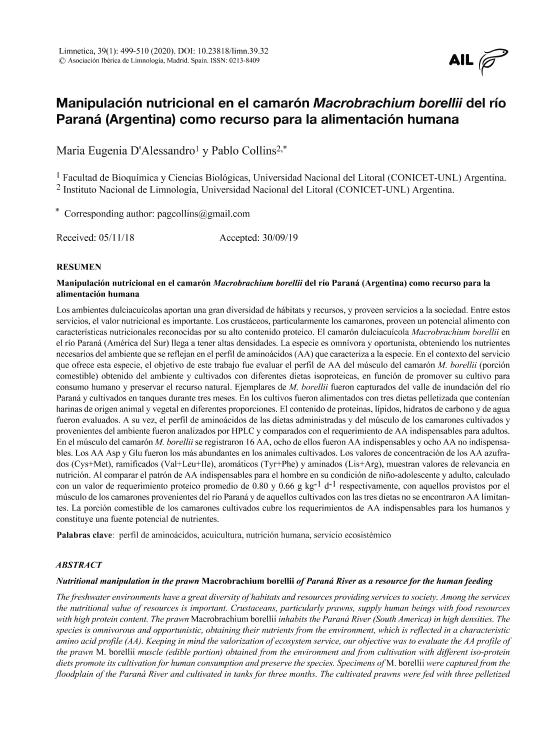Mostrar el registro sencillo del ítem
dc.contributor.author
D'alessandro, Maria Eugenia Guadalupe

dc.contributor.author
Collins, Pablo Agustin

dc.date.available
2021-12-23T15:07:46Z
dc.date.issued
2020-02
dc.identifier.citation
D'alessandro, Maria Eugenia Guadalupe; Collins, Pablo Agustin; Manipulación nutricional en el camarón Macrobrachium borellii del río Paraná (Argentina) como recurso para la alimentación humana; Asociación Española de Limnología; Limnetica; 39; 1; 2-2020; 499-510
dc.identifier.issn
0213-8409
dc.identifier.uri
http://hdl.handle.net/11336/149236
dc.description.abstract
Los ambientes dulciacuícolas aportan una gran diversidad de hábitats y recursos, y proveen servicios a la sociedad. Entre estos servicios, el valor nutricional es importante. Los crustáceos, particularmente los camarones, proveen un potencial alimento con características nutricionales reconocidas por su alto contenido proteico. El camarón dulciacuícola Macrobrachium borellii en el río Paraná (América del Sur) llega a tener altas densidades. La especie es omnívora y oportunista, obteniendo los nutrientes necesarios del ambiente que se reflejan en el perfil de aminoácidos (AA) que caracteriza a la especie. En el contexto del servicio que ofrece esta especie, el objetivo de este trabajo fue evaluar el perfil de AA del músculo del camarón M. borellii (porción comestible) obtenido del ambiente y cultivados con diferentes dietas isoproteicas, en función de promover su cultivo paraconsumo humano y preservar el recurso natural. Ejemplares de M. borellii fueron capturados del valle de inundación del río Paraná y cultivados en tanques durante tres meses. En los cultivos fueron alimentados con tres dietas pelletizada que contenían harinas de origen animal y vegetal en diferentes proporciones. El contenido de proteínas, lípidos, hidratos de carbono y de agua fueron evaluados. A su vez, el perfil de aminoácidos de las dietas administradas y del músculo de los camarones cultivados y provenientes del ambiente fueron analizados por HPLC y comparados con el requerimiento de AA indispensables para adultos. En el músculo del camarón M. borellii se registraron 16 AA, ocho de ellos fueron AA indispensables y ocho AA no indispensables. Los AA Asp y Glu fueron los más abundantes en los animales cultivados. Los valores de concentración de los AA azufrados (Cys+Met), ramificados (Val+Leu+Ile), aromáticos (Tyr+Phe) y aminados (Lis+Arg), muestran valores de relevancia en nutrición. Al comparar el patrón de AA indispensables para el hombre en su condición de niño-adolescente y adulto, calculado con un valor de requerimiento proteico promedio de 0.80 y 0.66 g kg-1 d-1 respectivamente, con aquellos provistos por el músculo de los camarones provenientes del río Paraná y de aquellos cultivados con las tres dietas no se encontraron AA limitantes. La porción comestible de los camarones cultivados cubre los requerimientos de AA indispensables para los humanos y constituye una fuente potencial de nutrientes.
dc.description.abstract
The freshwater environments have a great diversity of habitats and resources providing services to society. Among the services the nutritional value of resources is important. Crustaceans, particularly prawns, supply human beings with food resources with high protein content. The prawn Macrobrachium borellii inhabits the Paraná River (South America) in high densities. The species is omnivorous and opportunistic, obtaining their nutrients from the environment, which is reflected in a characteristic amino acid profile (AA). Keeping in mind the valorization of ecosystem service, our objective was to evaluate the AA profile of the prawn M. borellii muscle (edible portion) obtained from the environment and from cultivation with different iso-protein diets promote its cultivation for human consumption and preserve the species. Specimens of M. borellii were captured from the floodplain of the Paraná River and cultivated in tanks for three months. The cultivated prawns were fed with three pelletized. diets containing flours of animal and plant origin in different proportions. The contents of proteins, lipids, carbohydrates, and humidity were evaluated. The amino acid profile of the diets and the muscle of the cultivated prawn and from the environment were analyzed by HPLC and compared with the requirement of AA essential for child-adolescents and adults. In the muscle, 16 AA were recorded, eight were essential and eight not essential. Asp and Glu were the most abundant AA in the cultivated specimens. Sulfurized AA (Cys + Met), branched (Val + Leu + Ile), aromatic (Tyr + Phe) and aminated (Lis + Arg), were high. When comparing essential AA patterns for child-adolescent humans and adults, calculated with an average protein requirement value of 0.80 and 0.66 g kg-1 d-1 respectively for specimens from the Paraná River, and from those cultivated with the three diets, we found no limiting AA. The edible portion of the cultivated specimens covers the requirements of AA essential for humans, therefore, the cultivation of this species with artificial diets is a potential nutritional resource for humans.
dc.format
application/pdf
dc.language.iso
spa
dc.publisher
Asociación Española de Limnología

dc.rights
info:eu-repo/semantics/openAccess
dc.rights.uri
https://creativecommons.org/licenses/by-nc-sa/2.5/ar/
dc.subject
PERFIL DE AMINOÁCIDOS
dc.subject
ACUICULTURA
dc.subject
NUTRICIÓN HUMANA
dc.subject
SERVICIO ECOSISTÉMICO
dc.subject.classification
Biología Marina, Limnología

dc.subject.classification
Ciencias Biológicas

dc.subject.classification
CIENCIAS NATURALES Y EXACTAS

dc.title
Manipulación nutricional en el camarón Macrobrachium borellii del río Paraná (Argentina) como recurso para la alimentación humana
dc.title
Nutritional manipulation in the prawn Macrobrachium borellii of Paraná River as a resource for the human feeding
dc.type
info:eu-repo/semantics/article
dc.type
info:ar-repo/semantics/artículo
dc.type
info:eu-repo/semantics/publishedVersion
dc.date.updated
2021-08-27T20:26:25Z
dc.journal.volume
39
dc.journal.number
1
dc.journal.pagination
499-510
dc.journal.pais
España

dc.journal.ciudad
Madrid
dc.description.fil
Fil: D'alessandro, Maria Eugenia Guadalupe. Universidad Nacional del Litoral. Facultad de Bioquímica y Ciencias Biológicas; Argentina. Consejo Nacional de Investigaciones Científicas y Técnicas; Argentina
dc.description.fil
Fil: Collins, Pablo Agustin. Consejo Nacional de Investigaciones Científicas y Técnicas. Centro Científico Tecnológico Conicet - Santa Fe. Instituto Nacional de Limnología. Universidad Nacional del Litoral. Instituto Nacional de Limnología; Argentina
dc.journal.title
Limnetica

dc.relation.alternativeid
info:eu-repo/semantics/altIdentifier/url/http://www.limnetica.net/es/limnetica/39
dc.relation.alternativeid
info:eu-repo/semantics/altIdentifier/doi/http://dx.doi.org/10.23818/limn.39.32
Archivos asociados
